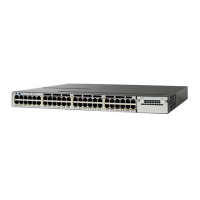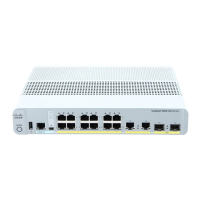Band Selection
Band selection enables client radios that are capable of dual-band (2.4- and 5-GHz) operation to move to a
less congested 5-GHz access point. The 2.4-GHz band is often congested. Clients on this band typically
experience interference from Bluetooth devices, microwave ovens, and cordless phones as well as co-channel
interference from other access points because of the 802.11b/g limit of three nonoverlapping channels. To
prevent these sources of interference and improve overall network performance, you can configure band
selection on the switch.
Band selection works by regulating probe responses to clients. It makes 5-GHz channels more attractive to
clients by delaying probe responses to clients on 2.4-GHz channels.
Related Topics
Configuring Advanced WLAN Properties (CLI), on page 36
Configuring Advanced WLAN Properties (GUI), on page 39
Prerequisites for WLANs, on page 21
Restrictions for WLANs, on page 22
Off-Channel Scanning Defer
In deployments with certain power-save clients, you sometimes need to defer the Radio Resource Management's
(RRM) normal off-channel scanning to avoid missing critical information from low-volume clients (for
example, medical devices that use power-save mode and periodically send telemetry information). This feature
improves the way that Quality of Service (QoS) interacts with the RRM scan defer feature.
You can use a client's Wi-Fi Multimedia (WMM) UP marking to configure the access point to defer off-channel
scanning for a configurable period of time if it receives a packet marked UP.
Off-Channel Scanning Defer is essential to the operation of RRM, which gathers information about alternate
channel choices such as noise and interference. Additionally, Off-Channel Scanning Defer is responsible for
rogue detection. Devices that need to defer Off-Channel Scanning Defer should use the same WLAN as often
as possible. If there are many of these devices (and the possibility exists that Off-Channel Defer scanning
could be completely disabled by the use of this feature), you should implement an alternative to local AP
Off-Channel Scanning Defer, such as monitoring access points, or other access points in the same location
that do not have this WLAN assigned.
You can assign a QoS policy (bronze, silver, gold, and platinum) to a WLAN to affect how packets are marked
on the downlink connection from the access point regardless of how they were received on the uplink from
the client. UP=1,2 is the lowest priority, and UP=0,3 is the next higher priority. The marking results of each
QoS policy are as follows:
•
Bronze marks all downlink traffic to UP= 1.
•
Silver marks all downlink traffic to UP= 0.
•
Gold marks all downlink traffic to UP=4.
•
Platinum marks all downlink traffic to UP=6.
WLAN Configuration Guide, Cisco IOS XE Release 3E (Catalyst 3650 Switches)
24 OL-32353-01
Configuring WLANs
Band Selection
